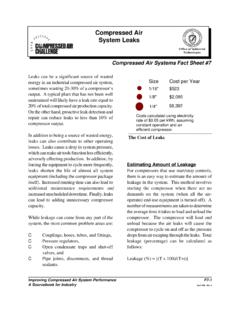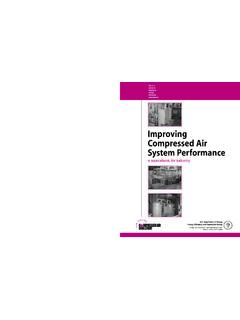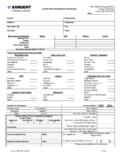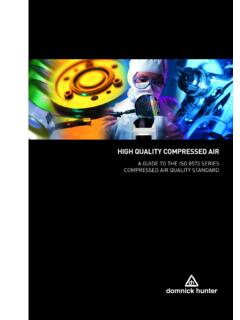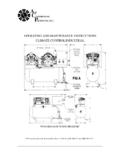Transcription of Compressed Air System Economics
1 Improving Compressed Air System PerformanceF9-1A Sourcebook for IndustryApril 1998 - Rev. 0 Compressed Air SystemEconomicsCompressed Air Systems Fact Sheet #9 Simple Calculation(100 hp Compressor)Annual Electricity Costs =(Motor full-load brake horsepower) x ( kW/hp) x(1 ) x (Annual Hours of Operation) x (Electricity Cost in$/kWh)For example: CMotor full-load bhp = 100 hpCAnnual hours of operation = 8,760 hours (3-shift,continuous operation)CFull Cost of electricity = $ electricity costs = (100 hp) x ( kW/hp) x (8,760 hours) x($ ) = $36,305 Delivering Compressed air to a manufacturingA Simple Calculation.
2 The following data isfacility is an expensive operation. Deliveryneeded for a quick calculation of electricity costsrequires costly equipment that consumesfor a compressor operating at full-load:significant amounts of electricity and needsfrequent maintenance. In spite of this, manyCCompressor motor nameplate rating (bhp),facilities have no idea how much theirCMotor nameplate efficiency (or an estimate ofcompressed air systems cost on an annual basis,efficiency),or how much money they could save byCAnnual hours of operation (hrs/year), andimproving the performance of these of electricity ($/kWh).
3 Electricity costs are by far the largest expense ofAnnual electricity costs can be calculated byowning and operating a Compressed air this information into the equation in theThe initial cost for a 100-hp compressor isfollowing text box:$30,000-$50,000, depending on the type ofcompressor and manufacturer, while annualelectricity charges for the same System can reach$50,000. Added to this are annual maintenancecosts, which can be 10% or more of the initialcost of the Fact Sheet presents a simple calculation toestimate annual electricity costs, and a moreaccurate calculation requiring Electricity CostsFull-load Operation.
4 Even if an aircompressor is not separately metered, estimatingannual electricity cost is simple. For moreanalysis techniques, see the AIRM aster softwarereferenced in the Resource and Tools section,This equation assumes the electric motor drivingand/or call the Compressed Air Challenge the compressor is 90% efficient (the 90 in thenumber listed in the Directory factor) -- a reasonable estimate for aCompressed Air System EconomicsImproving Compressed Air System PerformanceF9-2A Sourcebook for IndustryApril 1998 - Rev. 0 More Detailed Calculation(100-hp Compressor with 30 Power)Annual Electricity Costs =[(Full-load amps)x(volts)x( )x(power factor)]/1000(Annual Hours of Operation) x (Electricity Cost in $/kWh)For example: CFull-load amps = 115 ampsCVoltage=460 voltsCFull-load power factor = hours of operation = 8,760 hours (3-shift, continuous operation)CCost of electricity = $ Correction factor for 30 power= electricity costs = ((115 amps) x (460 volts) x ( ) x ( ) / 1000) x(8,760 hours) x ($ ) = $34,111modern System larger than 50 hp.
5 Newercosts. A calculation is shown in the next textenergy-efficient motors may have even , especially since the Energy PolicyAct minimum motor efficiency levels went intoeffect in late 1997. If the System uses an oldermotor that has been rewound several times, orhas a smaller motor, 80% efficiency (or themotor nameplate efficiency rating) should beused. For a more accurate assessment, add thehorsepower ratings for the parasitic loads fromany auxiliary motors to the compressor motorrating. It should be noted that the common practice inthe industry is to apply motors having a 15%continuous service factor and to use about two-thirds of this service factor.
6 This means that amotor having a nominal nameplate rating of 100hp may, in fact, be loaded to 110 bhp atcompressor full capacity and pressure. This maynot be expressed in the manufacturer=s salesliterature, however, so engineering data sheets forthe specific air compressor should be the motor is running into the service factor, thehigher horsepower estimate should be usedinstead of the nameplate horsepower Calculation with Measurements. Amore accurate way to determine electricityconsumption and costs involves taking electricalmeasurements of both full-load amps and full-load bhp and efficiency are notrequired for this calculation, although full-loadpower factor, which can be obtained from motormanufacturers, is.
7 The calculation takes full-loadamps, converts to full-load kW, and thenmultiplies by hours of operation and electricityPart-load Operation. If the Compressed airsystem operates below full-load at times, and hasa good control System , electricity costs will beless than if the compressor ran at full-load duringall hours of operation. Estimate the percentage oftime the compressor is running at full-load, andadd the percentage as another multiplier in theequation shown previously. Repeat thecalculation for the percentage of time thecompressor is running unloaded (or at part-load)and include a factor to compensate for thereduced load on the motor ( to is agood estimate for unloaded operation for rotaryscrew compressors and to forreciprocating compressors -- is used in theCompressed Air System EconomicsImproving Compressed Air System PerformanceF9-3A Sourcebook for IndustryApril 1998 - Rev.)
8 0 Calculation with Part-LoadOperation (100-hp Compressor)Annual Electricity Costs =[(Motor full-load brake horsepower) x ( kW/hp) x (Annual Hours of Operation) x (Electricity Cost in $/kWh)]x [(Percent of time running fully loaded) + ( ) x(Percent of time running unloaded)]For example: Full load motor efficiency = 90%CMotor full-load bhp = 100 hpCAnnual hours of operation = 8,760 hours (3-shift, continuous operation)CRuns 65% of the time fully loaded, 35% of thetime unloadedCUnloaded operation consumes 30 percent ofthe electricity of fully loaded operationCCost of electricity = $ electricity costs = [(100 hp) x ( hp/kW) x (8,760 hours) x ($ ) ] x [ + ( ) x ( )] = $27,410equation in the next text box).
9 Add the twoEnergy and Demand Charges -- results for total energy Your Electricity BillFor a more accurate calculation of energy costsrates stated in terms of dollars per kilowatt-hourfor compressors running at part-load, create a($/kWh). Electric utilities bill industrial customersnumber of tiers with the percentage of timeusing more complicated rate structures thatrunning at different percentages of include both energy ($/kWh) andManufacturers data on energy consumption fordemand charges ($/kW), and have different ratesthe different percentages of load will be on the level of consumption orThe following text box shows an exampledemand for a given month or season and cancalculation taking into account unloadedhave significant impacts on electricity costs customers.
10 When the economic impacts ofRemember, the calculations shown will onlyprovide a good estimate of energy consumption,not an exact calculations shown previously use electricityseasons. Demand charges are based on the peakefficiency measures are calculated, the actualmarginal cost of the electricity needs to beconsidered, taking into account energy anddemand charges, seasonal rates, and differentrates for different levels of and Electricity CostHigh pressure air is more expensive to produceand deliver than low pressure air. For a systemoperating at around 100 psig, a rule of thumb isthat every 2 psi in operating pressure requires anadditional 1% in operating energy costs.
